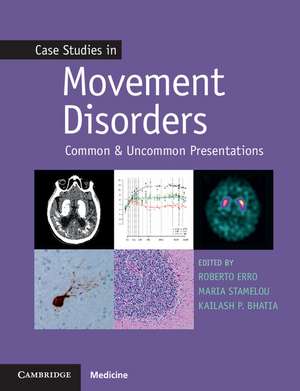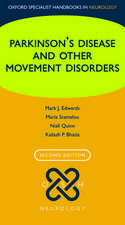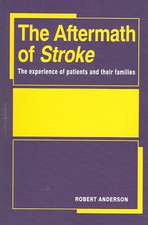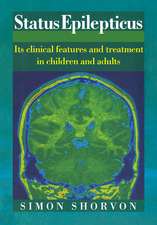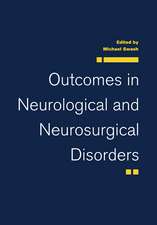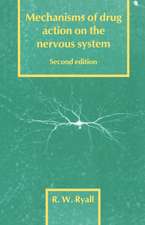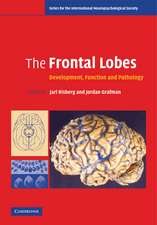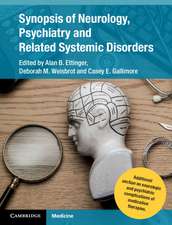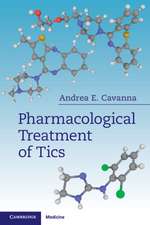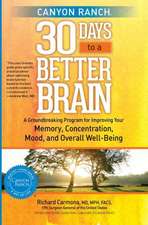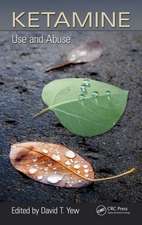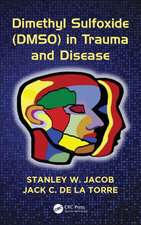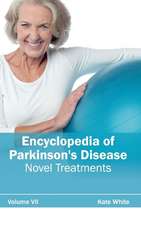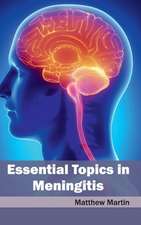Case Studies in Movement Disorders: Common and Uncommon Presentations: Case Studies in Neurology
Autor Kailash P. Bhatia, Roberto Erro, Maria Stamelouen Limba Engleză Paperback – 26 apr 2017
Preț: 498.06 lei
Preț vechi: 524.27 lei
-5% Nou
Puncte Express: 747
Preț estimativ în valută:
95.31€ • 98.95$ • 79.48£
95.31€ • 98.95$ • 79.48£
Carte disponibilă
Livrare economică 01-15 martie
Preluare comenzi: 021 569.72.76
Specificații
ISBN-13: 9781107472426
ISBN-10: 1107472423
Pagini: 170
Dimensiuni: 190 x 245 x 10 mm
Greutate: 0.41 kg
Editura: Cambridge University Press
Colecția Cambridge University Press
Seria Case Studies in Neurology
Locul publicării:New York, United States
ISBN-10: 1107472423
Pagini: 170
Dimensiuni: 190 x 245 x 10 mm
Greutate: 0.41 kg
Editura: Cambridge University Press
Colecția Cambridge University Press
Seria Case Studies in Neurology
Locul publicării:New York, United States
Cuprins
List of contributors; List of abbreviations; Section 1. Parkinsonism: 1. Parkinson disease; 2. Nonmotor Parkinson disease; 3. Isolated lower limb dystonia at onset of Parkin disease; 4. Parkinson's disease associated with SCNA mutations; 5. Steele–Richardson–Olszewski syndrome; 6. PSP-parkinsonism; 7. Corticobasal degeneration; 8. MSA – parkinsonian variant; 9. Prominent freezing of gait and speech disturbances due to Fahr disease; 10. A (familial) PSP look-alike; 11. Parkinsonian syndrome and sunflower cataracts: Wilson's disease; 12. Classic PD-like rest tremor in FTDP-17 due to a MAPT mutation; 13. Progressive parkinsonism with falls and supranuclear gaze palsy; 14. Very early onset parkinsonism; 15. Parkinsonism due to CSF1R mutation; Section 2. Dystonia: 16. Early-onset generalized dystonia: DYT1; 17. Early-onset jerky dystonia: an uncommon phenotype of DYT1; 18. Early-onset generalized dystonia with cranio-cervical involvement: DYT6; 19. Autosomal recessive isolated generalized dystonia: DYT2; 20. Dopa-responsive dystonia; 21. A complicated dopa-responsive dystonia: tyrosine hydroxylase deficiency; 22. Early onset generalized dystonia and macrocephaly: Glutaric Aciduria type 1; 23. PKAN misdiagnosed as 'progressive delayed-onset postanoxic dystonia'; 24. Oromandibular dystonia and freezing of gait: a novel presentation of neuroferritinopathy; 25. Generalized dystonia with oromandibular involvement and self-mutilations: Lesch-Nyhan syndrome; 26. Dystonia complicated by pyramidal signs, parkinsonism and cognitive impairment: HSP11; 27. H-ABC syndrome; 28. Dystonic opisthotonus; 29. Delayed-onset dystonia after lightning strike; Section 3. Tics: 30. Gilles de la Tourette syndrome; 31. Secondary tic disorders: Huntington disease; 32. Multiple hyperkinesias: tics and paroxysmal kinesigenic dyskinesia; 33. Functional tic disorders; Section 4. Chorea: 34. Huntington disease; 35. Generalized chorea with oromandibular involvement and tongue biting; 36. A Huntington disease look-alike: SCA17; 37. A newly recognized HD-phenocopy associated with C9orf72 expansion; 38. Persistent chorea due to anticholinergics in DYT6; 39. Dyskinesia without levodopa: long-term follow-up of mesencephalic transplant in PD; 40. Benign hereditary chorea; 41. Another cause of benign hereditary chorea; Section 5. Tremor: 42. Essential tremor; 43. Rest tremor and scans without evidence of dopaminergic deficit (SWEDD); 44. Neuropathic tremor; 45. A treatable disorder misdiagnosed as ET; 46. Thalamic tremor; 47. Shaking on standing: orthostatic tremor; 48. Palatal tremor; 49. Dystonic tremor and progressive ataxia; 50. Bilateral Holmes tremor in multiple sclerosis; 51. Primary writing tremor; Section 6. Myoclonus: 52. A case of 'essential' myoclonus; 53. Ramsey Hunt syndrome and Unverricht–Lundborg disease; 54. North Sea myoclonus due to GOSR2 mutations; 55. Ramsay Hunt syndrome and coeliac disease; 56. Asymmetric myoclonus and apraxia: corticobasal syndromep; 57. Rapidly progressive cognitive regression and myoclonus; 58. Familial cortical 'tremor'; 59. Prominent myoclonus and parkinsonism; 60. Axial myoclonus of uncertain origin; Section 7. Ataxia: 61. Slowly progressive unsteadiness and double vision; 62. Cerebellar ataxia with urinary incontinence: MSA-C; 63. Progressive ataxia, tremor, autonomic dysfunction and cognitive impairment; 64. Sensory ataxic neuropathy with dysarthria and ophthalmoparesis (SANDO) syndrome; 65. Ataxia telangiectasia without ataxia; 66. Anti-Yo related ataxia misdiagnosed as multiple system atrophy; 67. Late onset spinocerebellar ataxia; 68. Ataxia with splenomegaly: Niemann–Pick disease type C.
Notă biografică
Descriere
A thorough collection of movement disorders cases, each discussed by international experts and accompanied by illustrative video content.
